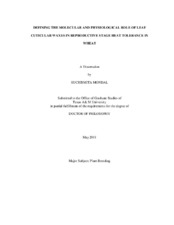| dc.contributor.advisor | Hays, Dirk B. | |
| dc.creator | Mondal, Suchismita | |
| dc.date.accessioned | 2012-07-16T15:57:19Z | |
| dc.date.accessioned | 2012-07-16T20:17:29Z | |
| dc.date.available | 2012-07-16T15:57:19Z | |
| dc.date.available | 2012-07-16T20:17:29Z | |
| dc.date.created | 2011-05 | |
| dc.date.issued | 2012-07-16 | |
| dc.date.submitted | May 2011 | |
| dc.identifier.uri | https://hdl.handle.net/1969.1/ETD-TAMU-2011-05-9449 | |
| dc.description.abstract | In wheat, cooler canopies have been associated with yield under high temperature stress. The objectives of this study were, i) to understand the role of leaf cuticular waxes as physiological adaptive mechanisms during reproductive stage high temperature stress ii) define quantitative trait loci (QTL) regulating leaf cuticular waxes and determine its link with the QTL for reproductive stage heat tolerance iii) define stable QTL associated with leaf cuticular waxes and yield stability across environments.
For the first objective, thirteen wheat cultivars were subjected to a 2-day heat treatment at 38 degrees C at 10 days after pollination (DAP). Leaf cuticular waxes, canopy temperature depression and stomatal conductance were estimated during high temperature stress. At maturity the percent reduction in yield components in each cultivar was calculated. The wheat cultivars 'Kauz' and 'Halberd' had significantly high leaf cuticular wax content of 2.91mg/dm^-2 and 2.36mg/dm^-2 respectively and cooler canopies. Leaf cuticular waxes were significantly correlated with leaf temperature depression and reduction in yield components.
A set of 121 recombinant inbred lines (RIL) population derived from the cross of heat tolerant wheat cultivar 'Halberd' and heat susceptible wheat cultivar 'Karl 92' was utilized for QTL mapping. The RIL population received a 2-day short-term high temperature stress at 38°C at 10DAP in 2008 and a long-term high temperature stress at 38 degrees C from 10DAP until maturity in 2009 in the greenhouse. The RIL population was also planted in College Station, Texas in 2009 and 2010 and in Uvalde, Texas in 2010. Leaf cuticular wax was estimated at 10DAP and leaf/spike temperatures were recorded during grain filling. Yield components were estimated after harvest. Heat susceptibility indexes for main spike yield components were estimated in the greenhouse.
Overall ten significant QTL were identified for leaf cuticular waxes each explaining 8-19 percent of the variation respectively. Stable QTL for leaf cuticular waxes were located on chromosome 5A and 1B and co-localized with QTL for leaf/spike temperature depression and HSI for kernel weight and single kernel weight of main spike. Another QTL on chromosome 1B contributed by Karl92 was found in the greenhouse and field environments and co-localized with a previously identified QTL on 1B for spike non-glaucousness. The results suggest that leaf cuticular waxes may reduce leaf temperatures and improve adaptation during high temperature stress. | en |
| dc.format.mimetype | application/pdf | |
| dc.language.iso | en_US | |
| dc.subject | Cuticular wax | en |
| dc.subject | Heat stress | en |
| dc.subject | QTL mapping | en |
| dc.title | Defining the Molecular and Physiological Role of Leaf Cuticular Waxes in Reproductive Stage Heat Tolerane in Wheat | en |
| dc.type | Thesis | en |
| thesis.degree.department | Soil and Crop Sciences | en |
| thesis.degree.discipline | Plant Breeding | en |
| thesis.degree.grantor | Texas A&M University | en |
| thesis.degree.name | Doctor of Philosophy | en |
| thesis.degree.level | Doctoral | en |
| dc.contributor.committeeMember | Ibrahim, Amir | |
| dc.contributor.committeeMember | Rooney, William L. | |
| dc.contributor.committeeMember | Briske, David D. | |
| dc.type.genre | thesis | en |
| dc.type.material | text | en |


